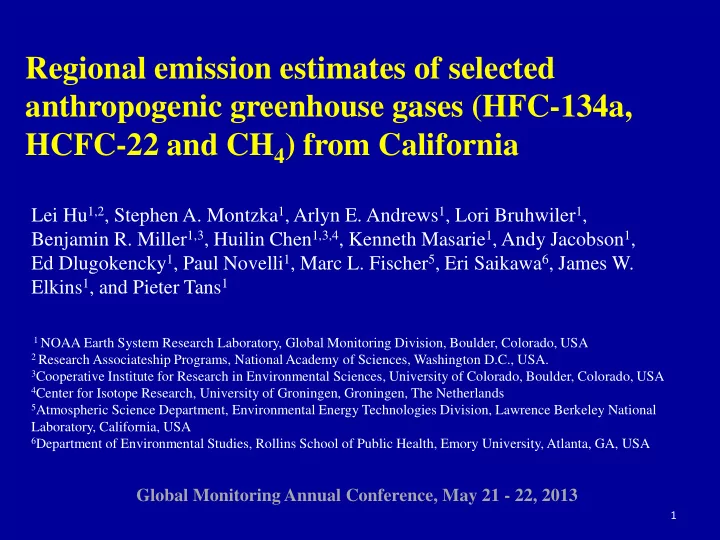

Regional emission estimates of selected anthropogenic greenhouse gases (HFC-134a, HCFC-22 and CH 4 ) from California Lei Hu 1,2 , Stephen A. Montzka 1 , Arlyn E. Andrews 1 , Lori Bruhwiler 1 , Benjamin R. Miller 1,3 , Huilin Chen 1,3,4 , Kenneth Masarie 1 , Andy Jacobson 1 , Ed Dlugokencky 1 , Paul Novelli 1 , Marc L. Fischer 5 , Eri Saikawa 6 , James W. Elkins 1 , and Pieter Tans 1 1 NOAA Earth System Research Laboratory, Global Monitoring Division, Boulder, Colorado, USA 2 Research Associateship Programs, National Academy of Sciences, Washington D.C., USA. 3 Cooperative Institute for Research in Environmental Sciences, University of Colorado, Boulder, Colorado, USA 4 Center for Isotope Research, University of Groningen, Groningen, The Netherlands 5 Atmospheric Science Department, Environmental Energy Technologies Division, Lawrence Berkeley National Laboratory, California, USA 6 Department of Environmental Studies, Rollins School of Public Health, Emory University, Atlanta, GA, USA Global Monitoring Annual Conference, May 21 - 22, 2013 1
Motivation Increasing atmospheric burdens of greenhouse gases (GHGs) Reducing GHG emissions Evaluating the degree to which GHG emissions have been reduced “Bottom-up” US emissions “Top-Down” Goals To provide accurate emission estimates To assess various “top-down” approaches 2
Outline • Surface flask sites • Emission estimates using a CO-based tracer ratio method • Further constrain fluxes using a Bayesian inversion • Summary for our preliminary findings 3
Surface flask sites Data periods: MWO: 2010 – 2012 STR: 2008 – 2012 WGC: 2008 - 2012 4
A CO-based tracer ratio method ∆ = χ − χ Enhancement: obs obs bkg ∆ = × Emissions of a trace x E E ∆ x CO gas (x): CO Many studies have used this method, but with different details! e.g. Li et al. (2005), Reimann et al (2005), Hurst et al. (2006), Yokouchi et al. (2006), Millet et al. (2009), Barletta et al. (2011, 2013), Wennberg et al. (2012) 5
Multiple approaches were considered and evaluated in the study Background ( χ bkg ) : (1) The 10 th percentile of surface data at three sites (e.g. Millet et al., 2009) (2) Marine background reference (Masarie and Tans, 1995) (3) “Background curtain” + air back-trajectories (Andrews et al., in prep.) ∆ x ∆ Three-monthly enhancement ratios (ER, ): CO (1) An orthogonal distance regression (e.g. Hurst et al., 2006; Barletta et al., 2011, 2013) (2) A median ratio approach (e.g. Miller et al., 2012) Estimating a state-wide emission: Approach (1): ER × CO inventory (e.g. Yokouchi et al. 2006; Wennberg et al. 2012) (a) ER= ER(STR)*0.25+ER(WGC)*0.25+ER(MWO)*0.5 3 3 (b) ∑ ∑ (s= site index; i,j=indices of latitudes and = • ER f ER f , , , , , i j i j s s i j s longitudes; f=footprints) = = s 1 s 1 Approach (2): Per capita flux (PCF) × population (e.g. Li. et al. 2006, Hurst et al., 2006; Barletta et al, 2011, 2013) (a) PCF= PCF(STR)*0.25+PCF(WGC)*0.25+PCF(MWO)*0.5 (b) 3 3 ∑ ∑ = • PCF f PCF f , , , , , i j i j s s i j s 6 = = s 1 s 1
Three-monthly enhancement ratios at three sites HFC-134a HCFC-22 CH 4 MWO MWO MWO ODR Median Ratio STR STR STR WGC WGC WGC 7
Emission Estimates Solid lines: ODR Dash lines: Median Ratios Approach 1a): ER × CO inventory, no footprint Approach 2a): PCF x Population , no footprint WGC was excluded; not using population Approach 1b): ER × CO inventory, with footprint Approach 2b): PCF × population, with 8 footprint
Further constrain fluxes using a Bayesian inversion To be optimized ∆ = − = λ + ε y y y fF obs bkg Enhanced Background Observed mixing ratios mixing ratios Footprint, calculated with NAM12-STILT Prior fluxes: derived from a CO- based TRM Model-data mismatch errors 9
Prior and posterior fluxes Prior ODR Median Ratio Posterior ODR Median Ratio 10
Comparison with a state inventory and other studies “CO- “CO- based” based” Exclude WGC Include WGC “Inversion” “Inversion” 11
Preliminary findings • Large difference was observed in emissions estimated with an ODR and a median ratio approach. • Emissions of HFC-134a and HCFC-22 from California during 2010 – 2012: 4.2 (± 2.3) Gg/y and 6.5 (± 2.3) Gg/y (we need to relook at the results after considering transport errors and using different transport) • Seasonality for emissions of HFC-134a and HCFC-22 from California: higher in summer than in winter. • CH 4 emissions from California, estimated with a CO-based tracer ratio method: 2.5 (1.8 – 3.2) Tg/y, about 1.2 – 2.1 times a state inventory (concerns: emissions of CH 4 and CO are not col-located; more work is needed to evaluate this approach). 12
A median emission ratio approach could be more capable of characterizing “far-field” emissions relative to an orthogonal distance regression. ~ 80% A non-Gaussian ~20% Distribution A non-Gaussian Distribution Summer 2010 MWO 13
Recommend
More recommend